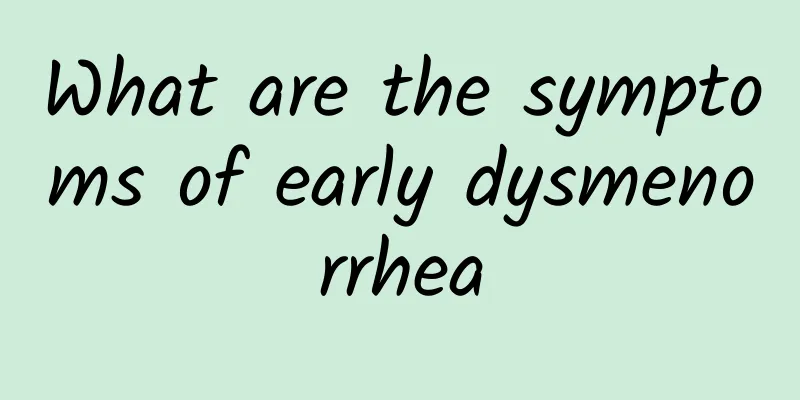What are the symptoms of early dysmenorrhea

|
Dysmenorrhea is a very common phenomenon among women, especially when menstruation comes. What are the early symptoms of dysmenorrhea? What are the early symptoms of dysmenorrhea? Let's discuss the early symptoms of dysmenorrhea: The early symptoms of dysmenorrhea are during or before and after menstruation. Most of them start at the onset of menstruation or a few hours before vaginal bleeding. The lower abdomen is bloated, cold, burning, tingling, dull, heavy, colic, spasmodic, and tearing. The pain extends to the sacrum and back, and even involves the thighs and feet, lasting 1/2 to 2 hours. The pain is mostly in the lower abdomen, and in severe cases it can radiate to the lumbosacral region or the anterior medial thigh. About 50% of patients are accompanied by systemic symptoms: breast pain, anal swelling, chest tightness and irritability, sadness and irritability, panic and insomnia, headache and dizziness, nausea and vomiting, stomach pain and diarrhea, fatigue, pale complexion, cold limbs, cold sweat, collapse and fainting. After the onset of severe abdominal pain, it turns into moderate paroxysmal pain, which lasts about 12 to 24 hours. It gradually disappears after the menstrual blood flows out smoothly, and occasionally there are patients who need to stay in bed for 2 to 3 days. The high incidence, wide range, close cycle and great pain have seriously affected the work and study of many women and reduced their quality of life. Symptoms of early dysmenorrhea also include primary dysmenorrhea: it often occurs during ovulatory menstruation, so generally there are no symptoms or only mild discomfort in the first 1 to 2 years after menarche. Severe spasmodic pain often occurs in young women 1 to 2 years after menarche. If regular dysmenorrhea occurs at the beginning or spasmodic dysmenorrhea occurs as late as after the age of 25, other abnormal conditions should be considered. Primary pain often disappears on its own after childbirth, or gradually disappears with age after marriage. The above is an introduction to the symptoms of early dysmenorrhea. Experts have explained it in detail for you. You should have a general understanding of it. If you still don’t understand something, you can call or contact our online experts. Dysmenorrheahttp://www..com.cn/fuke/tongjing/ |
<<: Know the symptoms of pelvic inflammatory disease
>>: What are the symptoms of uterine fibroids?
Recommend
What is the treatment for mild cervical erosion? Mild cervical erosion is suitable for treatment with two methods
In daily life, many women who suffer from cervica...
How do you get a Bartholin's gland cyst?
Bartholin's gland cyst is usually caused by t...
Superfoods help keep your intestines healthy in the new year
The weather changes during the Spring Festival, w...
What medicine can cure cervicitis and endometritis quickly?
When treating cervicitis and endometritis, choosi...
Get rid of fat legs! 10Q&A: Debunking Myths
The pear-shaped body is a common body shape among...
Will eating coix seed cause miscarriage? It is best not to eat it
Barley has the effect of strengthening the spleen...
Understanding the changes in the condition can help you take the best approach to treating vaginitis
In society, since the symptoms of vaginitis are d...
Where is the best place to treat irregular menstruation?
There is such a phenomenon in life that many fema...
Be a happy mom! 3 Worry-Relieving Nutrients to Help Lose Weight
When a baby is born, the happiest person is the m...
How to identify which type of adnexitis you have
Female friends who have been troubled by adnexiti...
Is the treatment of endometrial thickening expensive?
Endometrial thickness is a type of gynecological ...
How to treat female endometriosis
Nowadays, many young female friends suffer from e...
It’s hard to lose weight just by doing aerobics! The most elegant muscle training method: Barre exercise
Want to go exercise with your girlfriends, but yo...
Three common misunderstandings about dysmenorrhea that you don’t know
When it comes to dysmenorrhea, most female friend...
Can pelvic peritonitis be cured by taking medicine?
The occurrence of pelvic peritonitis is also rela...









